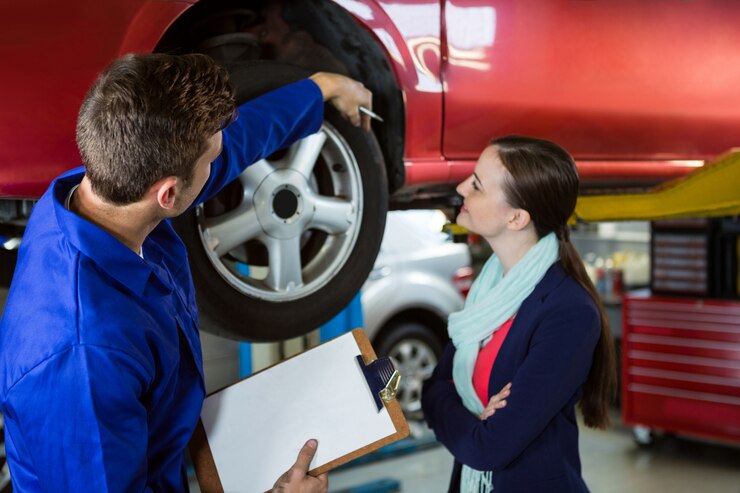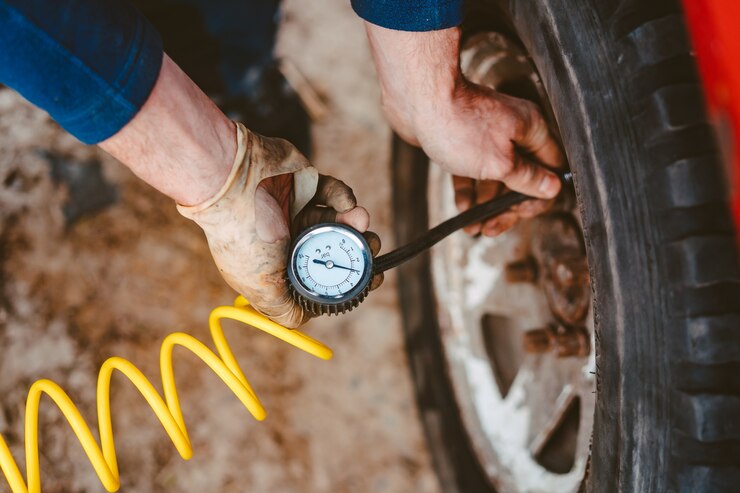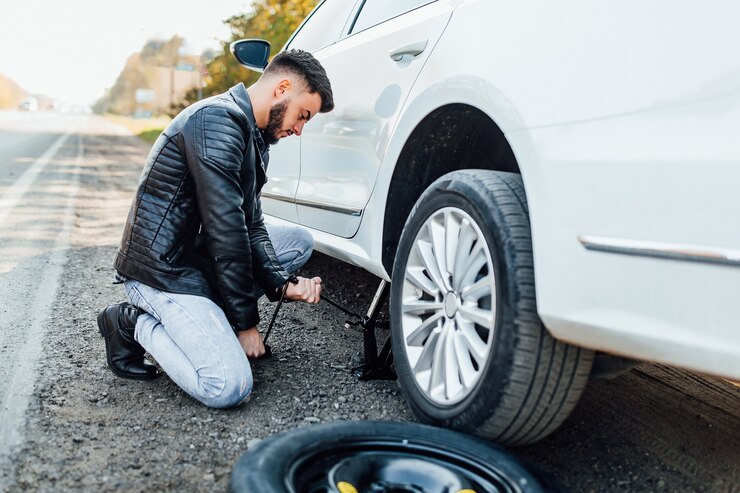Ultimate Tyre Safety Checklist By Wangara Auto Tyre
We, at Wangara Tyre Autos, have been dealing with tyres in Australia for a long time. We know that good tyres are super important for a safe drive.
Keeping your vehicle in good shape is crucial for safety when you travel.
Most people remember to check their cars yearly. But they often forget to look at the tyres. This is not a good habit. Even if you have really good tyres. They can wear out sooner if you don’t take care of them.
Taking care of your tyres not only keeps you safe but also helps your car use less fuel. Imagine having a flat tyre far from home with no repair shop nearby. Not a situation anyone wants to be in. So, make sure to add tyre checks to your regular car care routine.
We’ve put together the ultimate tyre safety checklist to help you avoid common problems while driving.
TL;DR: Ultimate Guide to Tyre Safety
- Check tyre pressure monthly and refill as needed
- Rotate tyres every 5,000 – 10,000 km for even wear
- Schedule wheel realignment every 10,000 km
- Ensure legal tread thickness of 1.5 mm
- Replace tyres over 10 years old
- Regularly inspect sidewalls for damage
- Learn basic tyre-changing skills
- Practice responsible driving habits
- Always carry a spare tyre for emergencies
- These tips ensure safe driving and prolong your vehicle’s lifespan.
Ultimate Tyre Safety Checklist
1. Maintain Correct Tyre Pressure
Air in your tyres gets less over time.
If your tyres are not pumped up enough. Your car uses more fuel – up to 7% more!
So, it’s essential to regularly check and adjust your tyre pressure. This simple step can save you money on fuel and make your tyres last longer. Keeping your tyres at the right pressure is crucial for both safety and the long life of tyres.
Follow these simple steps for maintaining tyre pressure:
- Step 1: Find the recommended pressure for your car on the driver’s side door frame, inside the fuel door, or glove box.
- Step 2: Unscrew the valve cap and attach the air compressor hose, preventing air from escaping.
- Step 3: Set the air compressor to the recommended pressure.
- Step 4: Fill the tyre, holding down the lever until you hear a beep, then screw the valve cap back on.
2. Rotate Your Tyres for even wear
Even Wear with Tyre Rotation
To ensure even wear and extend tyre life.
Rotate your tyres every 5,000 to 10,000 km.
If uneven wear is noticeable. Consider rotating them sooner. This practice enhances tread performance, resulting in improved cornering and braking. Remember the 5 tyre rotation rule, i.e. tyre rotation after every 5,000 km.
Rotating your car tyres means switching the front and rear tires. Tyre rotation costs between $50 and $100. This price usually covers both the rotation and balancing of the tyres.
3. Look for Damage on the Tyre Sidewalls
Roads can be bumpy. And your tyres can get hurt by things like curbs and potholes.
Always look at the sides of your tyres for cuts or bulges. If you see any damage. Ask an expert for help. If it’s a big problem. It’s safer to replace the tyre. When getting new tyres.
Trust a reliable tyre checker like Wangara Tyre Auto for good quality at a fair price.
4. Maintain Wheel Alignment for Better Performance
Continuous driving, turning, and encounters with speed bumps affect wheel alignment. Also, wheels can lose alignment over time, affecting the ultimate tyre and brake system. Also causing irregular tyre wear. Misaligned wheels impact handling and pose safety risks.
Schedule professional wheel alignment every 10,000 km or every 6 months.
This aligns with professional inspection and maintenance recommendations.
How to Replace Tyres Safely
Tip 1. Check Tyre Tread Depth
The tread on your tyres is really important. It’s like the grip on your shoes. As it wears down, your tyres can slip on the road.
You don’t need to be a car expert to check tyre wear indicators. Look for raised bars at the bottom of the tyre grooves. That’s the tread.
The legal minimum tread depth Australia is 1.5mm.
If it’s less than that, it’s not safe.
Legal requirements mandate tyre replacement when tread depth falls below 1.5mm. However, risks arise even at 3mm, especially in wet conditions or sudden braking.
Monitor your tyre wear indicator. Replace tyres before reaching the legal limit.
How To Check Tyre Tread Australia
- To check your tyre’s tread depth, use a tread depth gauge or the built-in tread wear indicator. Place the gauge or indicator into the tread grooves. If using a gauge, note the depth in millimetres.
- Alternatively, some tyres have built-in bars at the base of the grooves, known as tread wear indicators. If these bars are level with the tread, it’s time to replace the tyre.
- You can use a 5c coin to check the tread depth. If it’s uneven. It might mean a problem with your car’s steering. Get it fixed by a professional to stay safe.
Built-in Tyre Wear Indicators
Most modern tyres come equipped with tread wear indicators.
“Tread wear indicators are raised bars located at the base of the tread grooves.”
As the tyre wears down, these indicators become more visible.
When the tread is level with these bars. It signals that the tyre has reached the minimum legal tread depth. And replacement is necessary for optimal safety on the road.
Always pay attention to these indicators for timely tyre maintenance.
Tip 2. Consider Tyre Age
As tyres age, the bond weakens, leading to potential safety hazards.
Replace tyres over 10 years old. Even if they seem unworn.
How To Tell The Age Of A Tyre
To find out the age of a tyre, locate the Serial Tyre Identification Number (TIN) on the sidewall. The last 4 digits of the TIN indicate the week and year of manufacture.
For example, “1911” means the tyre was manufactured in the 19th week of 2011. Always check this number to ensure you know when your tyre was made.
How to Change a Flat Tyre on the Go
A surprising 30% of people may not know how to change a tyre. Learn this essential skill to save time and avoid being stranded.
Also, before going on a road trip. Always carry a spare tyre, a tyre jack, and a wheel brace.
Follow these steps to change a flat tyre:
- Step 1: Park safely and engage the parking brake.
- Step 2: Remove the hubcap (if present) and loosen the wheel nuts.
- Step 3: Position the jack correctly under the car, as per your owner’s manual.
- Step 4: Raise the car 5-10cm using the jack.
- Step 5: Remove the wheel nuts and the flat tyre.
- Step 6: Install the spare tyre, hand-tighten wheel nuts, lower the car, and remove the jack.
- Step 7: Fully tighten the wheel nuts using the wheel jack and replace the hubcap.
Make Your Drive Smooth by Caring for Your Tyres
To wrap it up, taking care of your tyres is super important for safe driving. Also, regular tyre maintenance is necessary for road safety and the ultimate tyre and auto long life.
Regularly check the tread. Keep the right tyre pressure. And look for damage. This will prevent problems, save you money, and make your tyres last longer.
Trust Wangara Tyre Auto for quality tyres that fit your car and won’t break the bank. Stay safe on the road by making these simple tyre care tips part of your routine.
By following the Ultimate Tyre Safety Checklist. Stay safe on the road by prioritizing the care of your tyres.
Upgrade Your Ride with Wangara Tyre Autos
Are you ready for superior driving?
Visit Wangara Tyre Autos today for top-notch tires and services for a safe driving experience. From premium tires to expert car services.
We’ve got your ride covered.




